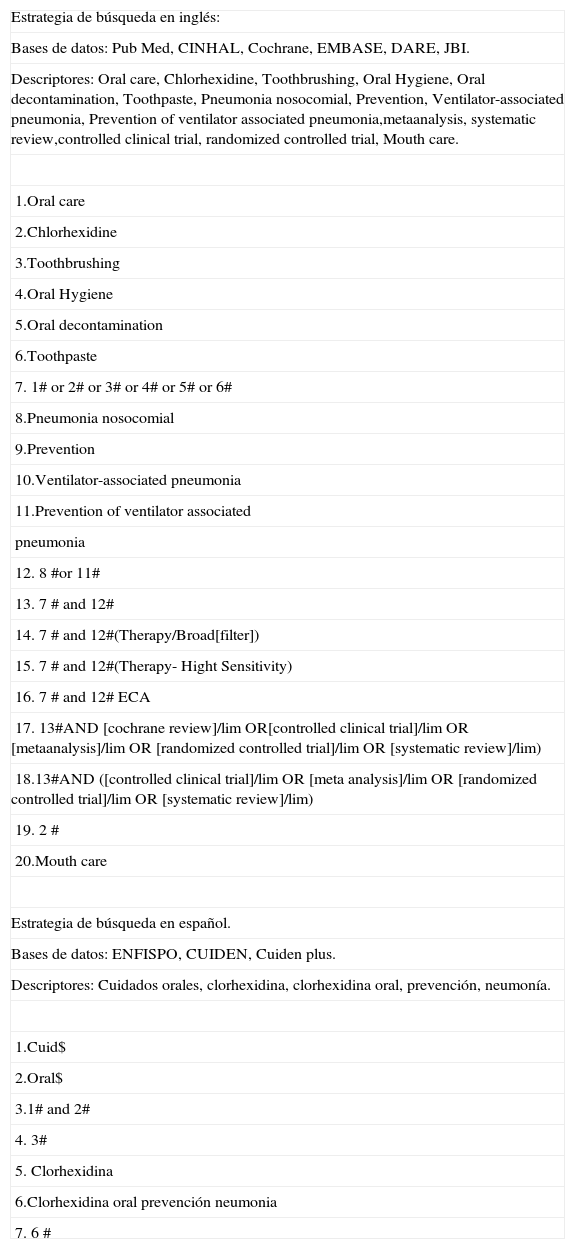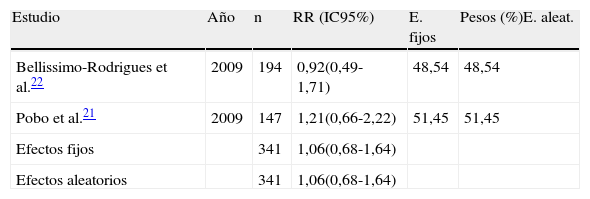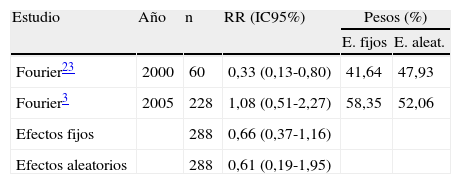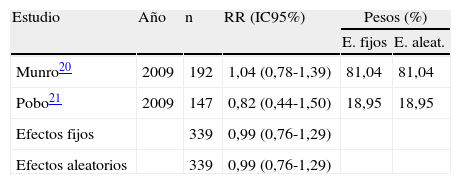Determinar la efectividad de los cuidados orales en la prevención de neumonía asociada a ventilación mecánica (NAVM).
MétodoBúsqueda en CINHAL, Cuiden Plus, Pub Med, EMBASE, ENFISPO, Cochrane, Cuiden, DARE, EBE, JBI, y búsqueda inversa, desde el comienzo de indexación de cada base hasta el 3-5-2010. No se ha restringido el idioma, edad, sexo ni patología de base. Se han incluido ECA que comparan los cuidados orales y se determina su efectividad en la prevención de NAVM. Se han analizado diferentes intervenciones para determinar cuál es más efectiva y protectora. Se ha utilizado Epidat 3.1 para síntesis de datos. Se han revisado 858 artículos, de ellos solo 14 cumplían los criterios de inclusión.
ResultadosBajo modelo de efectos aleatorios se ha determinado resultados estadísticamente significativos a favor de la clorhexidina como factor protector frente a NAVM RR=0,7065; IC 95% [0,5568-0,8963] .La aplicación de clorhexidina 0,12% dos veces al día RR=0,69; IC 95% [0,53-0,91] y clorhexidina 2% cuatro veces al día RR=0,53, IC 95% [0,31-0,90] aportan resultados estadísticamente significativos. Clorhexidina 0,12% y 0,2% tres veces al día y cepillado de dientes no aportan resultados estadísticamente significativos.
ConclusionesLa aplicación de clorhexidina en los cuidados orales es un factor protector frente a la NAVM. El cepillado de dientes no previene la NAVM: serían necesarios más estudios ECA con esta intervención.
To determine the effectiveness of oral care in preventing pneumonia associated with mechanical ventilation (VAP).
MethodA search was made for randomised clinical trials (RCTs) in CINAHL, Cuiden Plus, Pub Med, EMBASE, ENFISPO, Cochrane, Cuiden, DARE, EBE, JBI, and reverse lookup from the beginning of indexing of each database up to 3 May 2010. There were no restrictions on language, age, sex or underlying disease. RCTs that compared oral care and determined their effectiveness in preventing VAP were included. The different interventions were analysed to determine the most effective and protective. Epidat 3.1 was used for analysing the data. Out of a total of 858 articles reviewed, only 14 met the inclusion criteria.
ResultsUsing a random effects model statistically significant results were found in favour of chlorhexidine as a protective factor against VAP (RR=0.7065, 95% CI: 0.5568-0.8963). The application of 0.12% chlorhexidine twice a day gave an RR: 0.69, 95% CI: 0.53 - 0.91 and 0.2% chlorhexidine four times daily: (RR=0.53, 95% CI: 0.31 to 0.90), being statistically significant. The application of 0.12% and 0.2% chlorhexidine three times a day and brushing did not give statistically significant results.
ConclusionsThe use of chlorhexidine in oral care is a protective factor against VAP. Tooth brushing did not prevent VAP. More RCTs using this intervention are needed to confirm these results.
Artículo
Comprando el artículo el PDF del mismo podrá ser descargado
Precio 19,34 €
Comprar ahora















